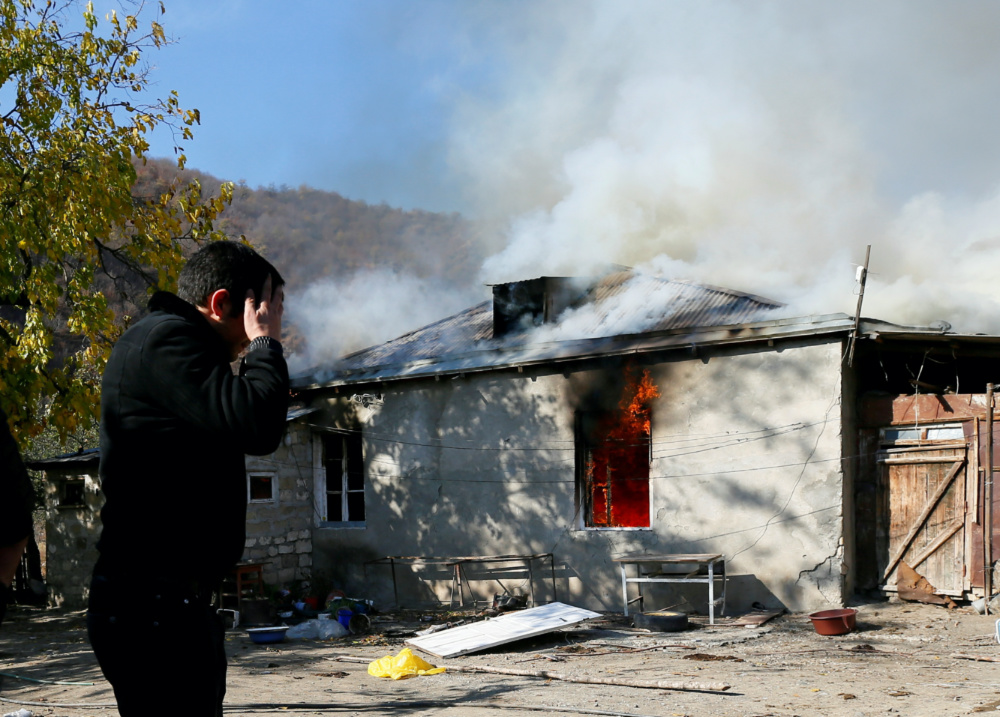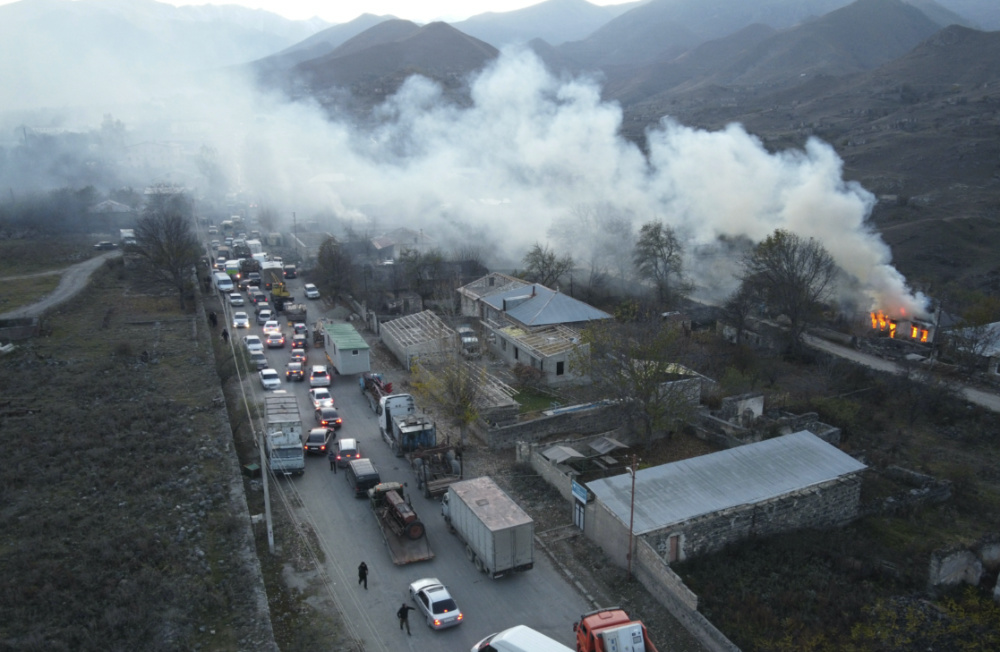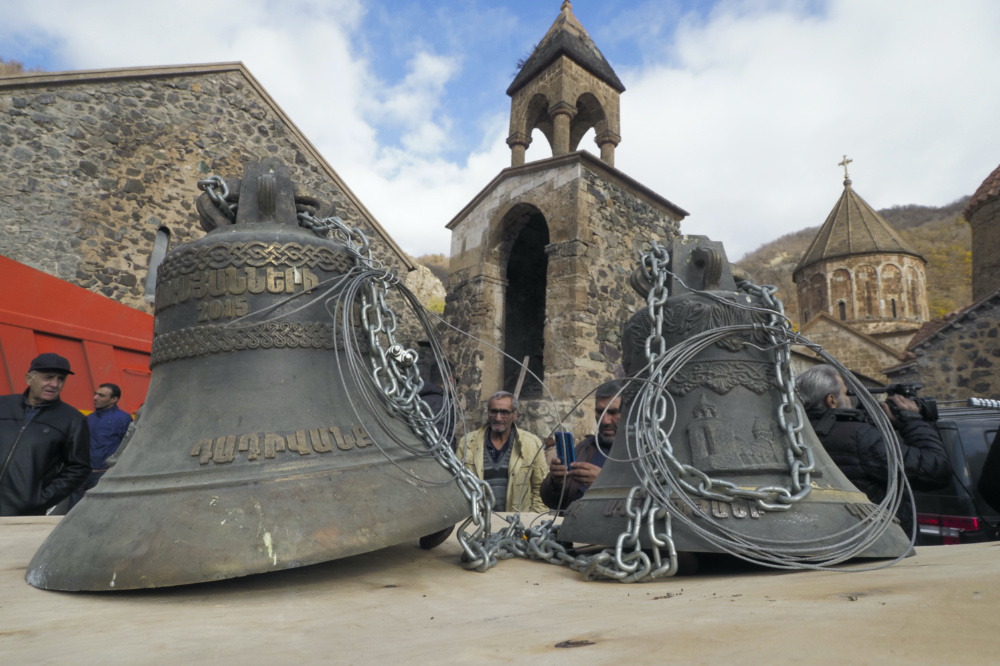
UMBERTO BACCHI, of Thomson Reuters Foundation, reports on the hardships facing those who have lost their homes following fighting between Armenia and Azerbaijan in the disputed Nagorno-Karabakh enclave…
Tbilisi, Georgia
Thomson Reuters Foundation
Sheltering in chilly school buildings and mountain sanatoriums, thousands of Armenians are bracing for a harsh winter after being driven from their homes by six weeks of fighting over the Nagorno-Karabakh enclave.
About 90,000 ethnic Armenians fled the mountainous enclave with the little they could take during the short war with Azerbaijan that ended with a Russian-brokered peace deal earlier this month, according to the United Nations.
As temperatures fall, some people want to return to the area, but widespread damage and unexploded ordnance means many could be stuck for months in temporary accommodation – either with relatives or in shelters often ill-equipped for the cold.

A man reacts as he stands near a house set on fire by departing ethnic Armenians, in an area which had held under their military control but is soon to be turned over to Azerbaijan, in the village of Cherektar in the region of Nagorno-Karabakh, on 14th November. PICTURE: Reuters/Stringer.
“It’s like a call of the soul,” said Margarita Ishkhanyan, 31, who comes from Shusha, the enclave’s second-largest town, and is thinking of trying to move to Nagorno-Karabakh’s main city, Stepanakert.
Under the terms of the peace deal, Stepanakert – which lies in territory internationally recognised as Azerbaijan – will stay in the hands of ethnic Armenians despite them being forced to cede other land to a victorious Azerbaijan.
“Ahead of us are three, four, very, very difficult months. Weather conditions will be harsh.”
– Irina Saghoyan, Eastern Europe director for charity Save the Children.
“I don’t think we’ll stay here for months,” Ishkhanyan said by phone from a children’s summer camp turned into an emergency shelter near the mountain town of Yeghegnadzor, where she found refuge with her mother and two children.
Temperatures in mountain areas near the border with Azerbaijan, where many of the displaced people are staying, are expected to fall well below zero in the coming months.
“Ahead of us are three, four, very, very difficult months,” said Irina Saghoyan, Eastern Europe director for charity Save the Children. “Weather conditions will be harsh.”
Armenia’s government did not immediately reply to a request for comment, but the Ministry of Labor and Social Affairs said on Facebook that it had set up an assessment centre to provide round-the-clock housing assistance to the homeless people.
The support included a one-off payment of 68,000 dram ($US137) for women, children, the elderly and disabled people, the Ministry’s post said.

Smoke rises from a burning house as cars and trucks stuck in a huge traffic jam climbing along the road from Kalbajar leaving the separatist region of Nagorno-Karabakh to Armenia, on Saturday, 14th November. PICTUIRE: AP Photo/Dmitry Lovetsky.
Armenian Prime Minister Nikol Pashinyan said last week the government wanted to prioritise the return of residents to the territory, helping people restore homes and damaged infrastructure.
More than 4,000 people went back to Stepanakert over the past week, the Russian Defence Ministry said on Friday.
But aid agencies say the city remains dangerous – potentially littered with unexploded shells and with many badly damaged buildings, according to the International Committee of the Red Cross.
“There is quite a bit of work to do to get the city back to a liveable and safe place for at least part of the civilians,” said the ICRC’s spokeswoman for Armenia, Zara Amatuni.
She said focus was on helping those who are still in Armenia, who include people unable or unwilling to return.
While ethnic Armenians retained control of Stepanakert, the peace deal handed swathes of territory to Azerbaijan after its forces recaptured chunks of land lost in an earlier war in the 1990s.
A D V E R T I S E M E N T
{subscriber-ad}
Ahead of the handover, some Armenians have adopted a scorched earth policy – setting fire to their own homes before leaving rather than allow them to fall into Azeri hands.
Liana Melkumyan, 48, who is staying in the Yeghegnadzor shelter, said she had no idea where her family could go to live next. Her hometown of Hadrut is now controlled by Azerbaijan.
“Why would we go back and live under Azerbaijani control?” she said by phone. “This whole war was to avoid this (and) so many thousands have died.”
In contrast, the six-week conflict has rekindled the hopes of Azerbaijani families who were forced from their homes almost three decades ago.
Gulmammad Mammadov, a 36-year-old who fled the Lachin area as a child, said he planned to return to his native village to restore his family home in the coming months.
“It still feels like a dream. I must see my village with my own eyes to fully convince myself that this is really happening,” he said by phone.
“Those lands aren’t just some lands with no meaning for us. They are part of who we are.”

People look at bells, removed form the Dadivank, an Armenian Apostolic Church monastery dating to the 9th century, as ethnic Armenians leave the separatist region of Nagorno-Karabakh to Armenia, Saturday, 14th November. The territory is to be turned over to Azerbaijan on Sunday as part of territorial concessions in an agreement to end six weeks of intense fighting with Armenian forces. Hundreds of thousands of Azeris were displaced by the war that ended in 1994. It is unclear when any civilians might try to settle in Karvachar – which will now be known by its Azeri name Kalbajar – or elsewhere. PICTURE: AP Photo/Dmitry Lovetsky.
The mass movement of people and congested living conditions in temporary accommodation have favoured the spread of the coronavirus, overstretching the health system in host communities, said a UN report published on 15th November.
Besides adequate shelter, people in temporary accommodation across the country need winter clothes and shoes, heaters, blankets as well as items such as hand-sanitiser and masks to help fend off COVID-19, according to the United Nations.
In Goris, a town near the border, 80-year-old retired surgeon and hotel owner Shahen Zeytourtchian said he and others helping to house people fleeing the fighting had caught the virus over the last few weeks.
“It was terrible because most of us were ill [but] we worked even in this time because there was no choice,” he said by phone, adding that he had since recovered.
After giving temporary accommodation to dozens of families at the height of the conflict, Zeytourtchian said his hotel was still home to about 40 people who had nowhere else to go.
Food has been provided by the local council, but the hotel has been footing all the extra bills. Still, he said he would let the non-paying guests stay on until they had somewhere else to go: “I have no idea how long they can stay here but I have no [other option].”





